In October 2017 I made my long trekking trip to Scotland and hiked the West Highland Way. That 96 miles hike should not be underestimated, but unfortunately, I did. I’ve tried to make it cheap and bought the first low-priced backpack I saw. It turned out to be a horrible mistake. My shoulders felt like they were about to crack as I walked the last several miles. In addition to that, my gear was a mess, and I kept forgetting where I put stuff all the time. For that reason, I feel it is a personal obligation of mine to help you pick the right 40-liter backpack.
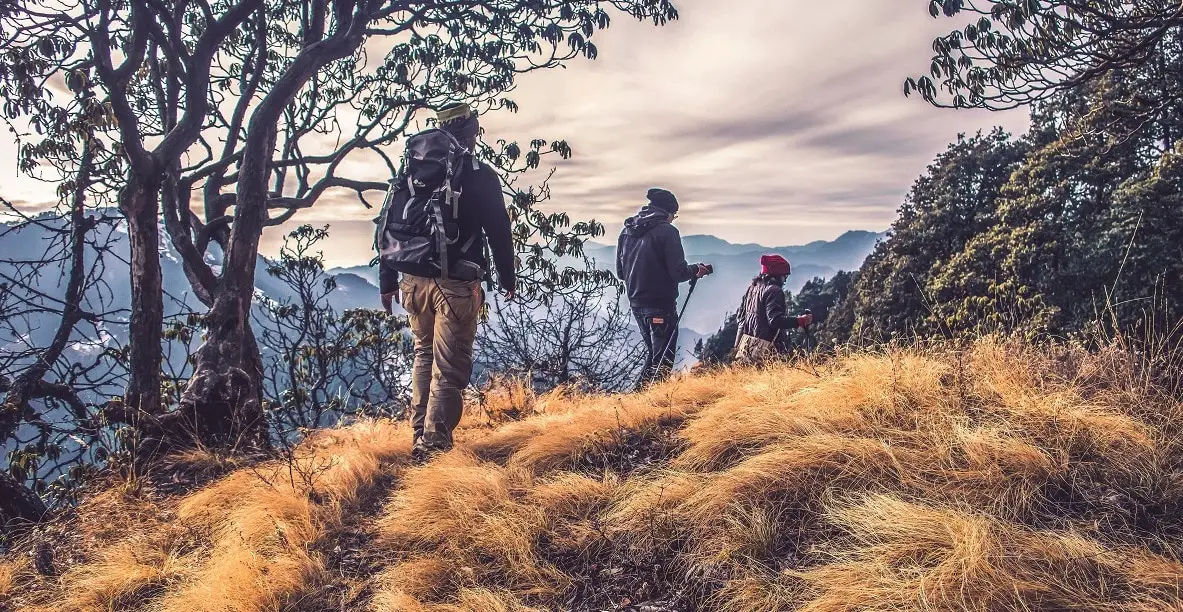
After in-depth research, I am ready the present you with some results. To get the right 40-liter backpack, I highly recommend it to be water resistant, feature a hydration system and proper straps. Moreover, it should have a well-designed hiking structure and be lightweight. Later on, I will elaborate on these specifics and show you some of the best backpacks I have managed to find.
The 40-liter backpacks feature the perfect size for traveling. They are roomy enough to store your hammock, clothes, towel, books, and food, but not too large for a day walk around the city. Moreover, they usually fit inside an airplane cabin so that you can carry them close to you during flights.
How important is water resistance?
Rain is an unanticipated factor which may catch you in different situations. If you travel a lot, you probably got wet sometimes while hiking, camping or just walking down the city streets.
We usually keep our most valuable stuff inside our backpack. It may contain our precious diary, an expensive camera or a fascinating book we’ve planned on reading. Water can merely ruin it all, and nobody likes digging out the umbrella which is buried at the bottom.
For that reason, it is imperative to pick a waterproof backpack. Some backpacks feature waterproofness by having polyester fabrics or water-resistant nylon.
That would keep water out and increase your backpack durability. Others come with a built-in rain cover, that is also ok.
What is a hydration system?
Imagine you are hiking on a hot day with a full occupied backpack.
Drinking breaks once in a while are crucial to prevent dehydration. But now you have to find the bottle you filled in the morning between all your stuff. Sounds frustrating right?
For that, your backpack should have a hydration system in it. So what is it exactly? A hydration system is merely a built-in function in your pack that provides natural hydration while walking.
Most of the times it is a hole in your backpack which connects the inside with the outside – through this hole passes a tube which relates to the hydration bladder located inside.
Some backpacks include the bladder itself when others feature a drinking hole. In the last case, the bladder should be bought separately. Packs with a laptop compartment most of the times feature a hydration hole. There is no point in two different chambers, you may place your hydration bladder inside the laptop compartment while walking.
What should be the backpack structure?
My in-depth research brought up three critical features the ideal backpack should answer as a part of its structure. That would be its compartments, ventilation system and a high quality padded back.
Compartments
Keeping your gear organized will help you later on when something is suddenly needed. Nobody should keep all in one place, that would cause a terrible mess.
Moreover, liquids and cleaning accessories usually should have their compartment. The proper amount of chambers should be around two or three, more than that would turn it clumsy and awkward to manage.
However, one compartment backpack may serve more space. Those backpacks would resemble a suitcase when opened and would be easy to carry by hand. In a case like this, it is recommended for the pack to have internal straps to tighten your gear.
For most of you who like to stay connected, I suggest making sure your backpack has a laptop compartment. Yes, even hiking backpacks offer that function, and some of them are also padded to keep your laptop secured.
Ventilation
You have probably heard about ventilation in tents or boots selection, but what about backpacks?
Well, some of them are also ventilated. With backpacks, ventilation is mainly within the shoulder straps. Breathable padded straps would allow you to carry your gear for long distances without gaining moisture.
That would prevent injuries, infections and for that improve your general hiking experience.
Padded back
No matter how light your gear is, without the proper backpack back, you would probably start feeling back pains.
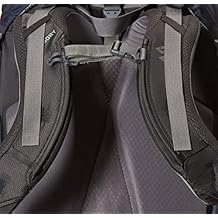
The high-quality backpacks would feature a good design orthopedic back, that would protect you from injuries. Do not underestimate that key factor, no matter your age or current health condition.
What are good backpack straps?
Well, straps are the most felt part of your backpack. We all know the sore shoulders after a long day hike. I had a horrible experience with my previous bag. At some points during a hike day, my shoulders were burning.
I kept playing with the weight balance consistently to relieve pressure. For that reason, I believe proper straps should be an integral part of backpack choice.

Choose the one with padded straps that secure your shoulders correctly. If it is too tight or tends to slip, it creates terrible frictions forces that hurt. With proper padding, a heavyweight backpack would be barely felt.
Can a 40-liter backpack be lightweight?
It is pretty apparent your backpack should be lightweight – and yes, 40 liters could be too.
When hiking long distances, every pound matters, the experienced among you probably know that. Did you know that lightweight backpacks can get beneath 1 pound?
Some of the lightest can be simply folded into a small pouch and transform into a super compact handheld carry bag.
This is highly recommended for those of you who want a high capacity backpack but may not use it every single day. These backpacks fabric is usually based on nylon, which ensures long standing durability.
Recommendations
After reviewing some crucial factors intensely, it is time to present some actual products. I have included pros and cons for each one to help you make a smooth and wise decision.
1. Osprey Packs Farpoint 40 Travel Backpack
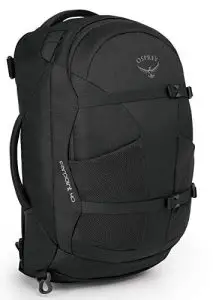
PROS:
- Stowaway backpanel
- Laptop and tablet sleeve
- Dual front mesh pockets
- Front Compression Straps
- Padded Handles
CONS:
- Lack of internal compartments
- Colors – Blue / Red / Grey
- Weight – 3 pounds
Ospreys Farpoint 40 is excellent for city and nature traveling. Its mesh back panel provides proper ventilation that would prevent sweat moisture. Also, it features a stowaway back panel, creating a slimmer profile when traveling. The Farpoint’s dual compression straps will keep your gear stable while hiking.
Besides, it features a large internal storage compartment to provide maximum room. That compartment is secured with two internal compression straps, so you don’t have to worry about your gear getting messy on the hike.
2. Gregory Mountain Products Compass 40 Liter Backpack
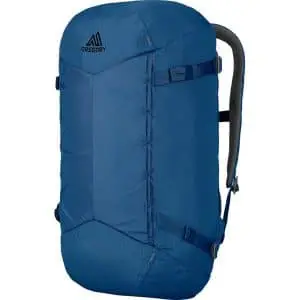
PROS:
- External access laptop compartment
- Weather resistant
- Padded shoulder straps
- Padded backpanel
CONS:
- Accessibility is challenging
- Colors – Blue / Black
- Weight – 2.24 pounds
Compass 40 is a fantastic choice for city, nature, and business travel. It features an external-access padded 15-inch laptop compartment with tablet sleeves. Besides, it has a top accessory pocket with key clip and an internal zippered mesh security pocket for internal organization. It’s sided compression straps make it easy to carry heavy weight equipment, while the top and bottom grab handles turn it into an easy carry bag when needed.
3. Osprey Packs Fairview 40 Travel Backpack
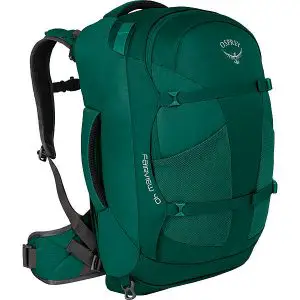
PROS:
- Stowaway backpanel
- Laptop and tablet sleeve
- Lockable sliders on main compartment
- Two internal compression straps
CONS:
- Front compartment space is limited
- One compartment
- Colors – Grey / Green
- Weight – 4.38 pounds
The Fairview 40 Travel Backpack is excellent for wilderness traveling and weekends getaway around the city. The stowaway back panel can easily be zipped away to create a slimmer profile, making it great for airplane travel. Its large compartment provides enough room for your belongings while the internal straps make sure they stay organized.
4. Deuter Transit 40 Carry-On Travel Backpack

PROS:
- Flight approved
- Separate bottom compartment for shoes
- Laptop sleeve
- Small front stash pocket for documents
- Waterproof
- Padded shoulder harness
CONS:
- One main compartment
- Colors – Anthracite
- Weight – 3 pounds
The Deuter Transit 40 Carry-On is the right choice when traveling between countries. It has been approved for carrying on baggage and conveniently fits inside overhead compartments. For those among you who bring extra shoes – you may store them in the bottom chamber so your gear doesn’t get dirty. While being both lightweight and waterproof, the Deuter Transit 40 is the right choice for both city and wilderness travel.
5. Mountaintop 40 Liter Hiking Backpack

PROS:
- 6 adjustable straps
- Laptop compartment
- Bladder tube holding place
- Meet size requirements for most airlines
- Rain cover for outdoor camping
CONS:
- Not enough pockets for small items
- Suits better small people
- Colors – Black / Blue / Fuchsias / Grey / Kahqi / Green / Orange
- Weight – 2.1 pounds
The great and cheap Mountaintop 40 features six adjustable straps for tying up your hammock, sleeping bag, mat, and other gears. With a computer compartment and being size-approved for most airlines, it is perfect for international traveling.
For weather protection, Mountaintop made sure to equip it with a rain cover, so you can go outdoor camping without any worries of getting wet. Do not skip checking this great product out!
6. G4Free Large 40L Lightweight Water Resistant

PROS:
- Handy and ultra-lightweight
- Water resistance
- Breathable padded shoulder straps
- Camera compartment
CONS:
- 1 Compartment
- No laptop compartment
- Colors – Black / Blue / Grey / Light Blue / Orange / Purple / Green
- Weight – 0.8 pounds
The G4Free combines durability, water resistance and ultra-lightweight, all in a beautiful and cheap backpack. When it is not needed, you may fold it into its self-containing pouch, transforming it into a compact handheld carry bag. The G4Free top features a double-sided pouch for small items storage, while the exterior accessible part may store your cell phone or camera.
Frequently Asked
- Q: How to wash hiking backpacks?
- A: Hiking packs can be washed with a washing machine. To do so, you should first empty your backpack. Leave the zips open and push it into the machine. Wash it according to the manufacturer recommendations. You may also roll and tie the backpack straps to prevent them from being caught in your machine.
- Q: How to wear a hiking backpack?
- A: You should adjust your shoulder straps in a way your backpack is high on your back, and the straps sit perfectly on your shoulders. They shouldn’t be too tie nor too loose – so your pack doesn’t sway from side to side while walking. Some backpacks feature chest straps. If your bag also does, you should use it.
- Q: How to choose the right backpack?
- A: Well, there are several things to consider. First, it depends on your journey. If you are planning to camp or hiking longs distances, then you should pick a lightweight backpack with water resistance. If you are planning to travel around the city, a pack that feets airplanes cabin and has enough room will suit you better.
- Q: How many liters should you backpack have?
- A: That factor mainly depends on your hiking distance and laundry washing availability. In a case you are planning on camping, without any washing machines or grocery stores on the road, a 40-liter backpack would fit for 4-5 days tops. For longer hikes, a 50-70 liter hiking backpack would be a better choice.
- Q: What should I pack inside my backpack?
- A: You should pack as less as possible to keep your backpack lightweight. Be aware that on long hike distances, every pound matters. Plan the amount of food you would consume each day and pack accordingly – no more and no less. Play it smart with your clothing too. Do not pack different clothes for each day; you may be able to hand them to dry during night time.
- Q: How heavy should a backpack be?
- A: Your backpack should weigh between 25-35 pounds. More than that would make it difficult to walk for long without shoulders pain. Try not to pack unnecessary stuff and stick only to what you may use. Most people pack extras on their first journey – to be sure. Try eliminating that thought – you can handle almost every situation on nature even with the necessary equipment.
Conclusions
In summary, picking the right backpack is not difficult if you know what to look for. For some of you, the backpack structure is the essential ingredient, while others prefer it would be lightweight and waterproof.
From what I saw, it is difficult to find it all in one ‘perfect’ backpack. For that reason, it is crucial you go over each pack features and stick to those who matter you most.
I hope I made your purchase decision more comfortable, let me know your thoughts or hesitations by leaving a comment below!
Sources
- Hydration pack – Wikipedia, 2018.
- Pain in the Backpack – WebMD, 2018.
- Right and Wrong Ways to Wear a Backpack to Prevent Pain – verywellfit, 2018
- What Makes a Good Backpack Strap? carryology, 2011
- How much should your pack weigh? Rei, 2018

